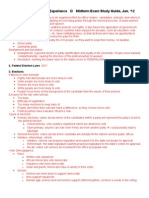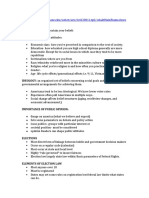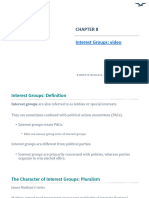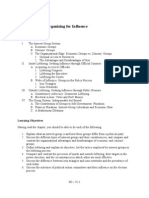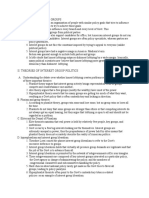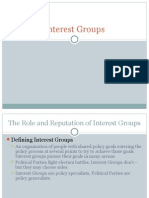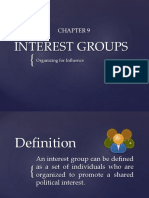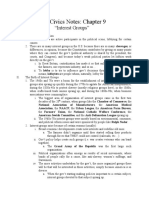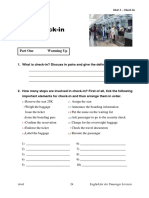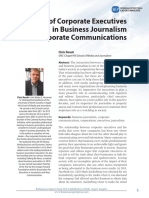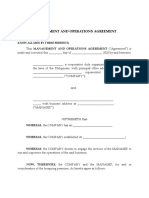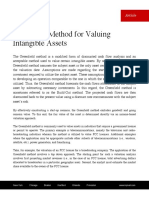Chapter 8 Political Parties, Candidates, and Campaigns: Defining the Voter’s Choice
Political Party: ongoing coalition of interests joined together. Wants its candidates to be elected
for public office under a common label. Provides people opportunity to make a choice and
influence direction of government
Party-centered politics: U.S. campaigns between Rep. & Demo. across country
Candidate-centered politics: Campaigns also based on individual strategies. Candidates choose
organization and their own issues to address
Party Competition & Majority Rule: The History of U.S. Parties
Numbers = power when organized.
Party competition: between Rep. & Demo. Voters unite behind a single association despite diff.
backgrounds.
Legalization of parties is first step toward a fair democracy
Competition among parties gives popular majorities a chance to influence how they will be
governed
-The First Parties-
Jefferson & followers were Republicans. Supported states rights, small landholders, portrayed
themselves as heirs of American Revolution’s legacy of self- gov’t & political equality
Hamilton & followers were Federalists. Represented america’s political values and traditions.
Strong national gov’t & commercial interests
Federalists commercial/ wealthy interests made them a gov’t of rich/wellborn.
Jefferson won presidency in 1900, federalists and their philosophy never again held sway
So called Era of Good Feeling, James Monroe 2nd term, ran unopposed. Next year republicans
split up. Andrew Jackson formed Democratic Republicans which held the interests of ordinary
people.
-Andrew Jackson and Grassroots Parties-
Grassroots party: Jaskson’s demo.party had committees in local state & national levels.
Chapter 9 Interest Groups: Organizing for Influence
Interest group positive - Pluralist theory states society’s interests are most effective through
group efforts
negative – groups can have too much power. Public interest can be harmed.
Single-issue politics: numerous groups for every policy issue and pressing for their demands no
matter the cost to society as whole.
�Interest group: aka faction, pressure group organize members & pursue a common political
goal. (i.e. N.O.Women, World Wildlife Fund, NRifleA.)
Political party is broad all about winning appeal to diverse voters, positions change according to
voters preferences.
Interest group is specific, immediate concern to its members, can participate in elections but
purpose is influencing public policy
The Interest-Group System
Interest groups unequal. Difference in financial resource, incentives, time, skill, contacts. More
organized, more influential
-Economic Groups-
Econ. Groups : focuses on profits, employment, wages, protect occupation. Best organized. (4
types- business, labor, agricultural, & professional)
Group needs headquarter, expert staff, & communication facilities.
Abundance in econ. Groups because have easy access to $ (econ. & business activities)
sometimes members don’t pay dues
Private (individual) goods: group can give direct benefits 2 individ. (i.e. United Auto Workers,
members get high paying jobs (material incentive) )
Business lobbyists focus on tax, tariffs, & regulations. ½ of lobby groups are business.
“size factor” , big companies say gov’t should pay more attention to them. But smaller
firms are more cohesive. However, big firms are less in number ( i.e. “big 3” GM, ford,
Chrysler) they tend to work together to save $. Therefore consumers only take the
damage
Labor groups promote union members/ workers in general. (i.e. United Mine Workers, AFL-CIO
in D.C. dominant labor group)
decrease in labor unions b/c (-) in unskilled jobs. (+) in skilled. Professionals think they
are financially secured, no need for labor union.
Labor groups now organize service and public employees (i.e. teachers, social workers,
bureaucrats) instead of skilled/ unskilled laborers
Agricultural largest group is American Farm Bureau Fed. But there are more smaller lobbies.
Not all focus on one thing . (i.e. Farm Bureau deals with
agribusiness & large farms. Farmers Union deals w/ family farms. Other lobbies include
American Soybean Assoc. & Assoc. Milk Producers)
Professional groups are 4 careers (i.e. Amer. Med. Assoc. opposes gov’t policy that limits
physicians’ autonomy. Amer. Assoc. of Uni. Professors)
-Citizens’ Groups-
�Aka nonecon. groups : gather for purposive incentives: opportunities to promote causes they
believe in. (i.e. anti war, help environment, public prayer)
Harder time to acquire resources. Cannot generate profits from econ. Activity.
Collective/public goods: shared benefits, not individ. ( i.e. nat. forests , air) so less incentive to
join
Free-rider problem: ppl gain benefits when they don’t contribute. (i.e. Naitonal Public Radio
funded by only 10% of listeners but 100% benefits)
b/c individ. Fees are small in proportion it makes no diff. free rider prob. Makes citizen
groups less organized than econ. Groups
increased membership thru individ. Benefits (i.e. social activities & organizational newsletters) .
thru computers, group organizers mail request for a
small fee . computers allowed group to contact potential members so there’s an increase
in members today than in past
internet plays major role. Helps lobbyists with global campaign and link global activists and
groups.
Public-interest groups: despite name, leaders are not elected by the public at large & issues
targeted are their own choosing. (i.e. League of Women
Voters seeks policies like voter registration simplification which benefit general public)
Single-Issue Groups: influence policy in one area. (i.e. Nat. Rifle Assoc.) . single issue groups
increased sharply recently
Environ. Groups can be either public-interest or single-issue. (i.e. Sierra Club –preserve
scenic areas. Greenpeace USA, Wilderness society)
Ideological Groups: broader than single-issue. Based on values, philosophies, and moral
positions (i.e. NAACP, NOW, Christian Coalition)
-A Specific Category of Interest Group: Governments-





